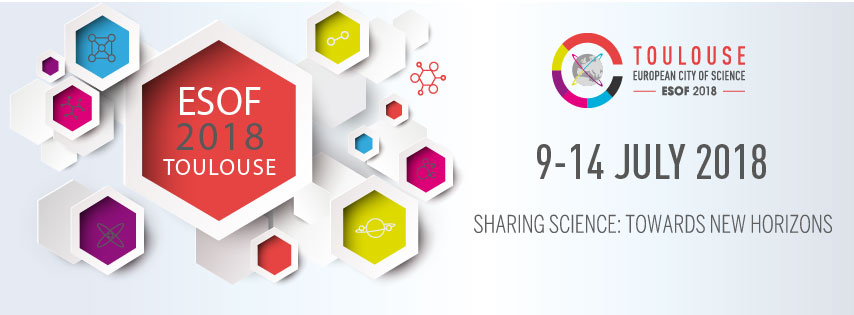How to preserve our ancient books and drawings from deterioration? Results of the study answering to such questions were presented at the Science in the City Festival – ESOF 2018
Location9-15 July 2018, Place du Capitole, Toulouse - France
 Many important documents, drawings and maps are in danger, due to the highly corrosive Verdigris green copper pigment, consisting of a variety of copper acetates widely used from the 13th to the 19th century.
Many important documents, drawings and maps are in danger, due to the highly corrosive Verdigris green copper pigment, consisting of a variety of copper acetates widely used from the 13th to the 19th century.
The two youngest CERIC users, Mitja Denac and Bor Kolar Bačnik, from the high school Gimnazija Vič, conducted a research to evaluate existing and new stabilization treatments for ancient documents where historical green pigment Verdigris was applied, in order to equip conservators with superior treatment solutions. To evaluate these treatments, they developed a new application technique that would yield a facile and fast method to create reproducible model samples, needed for evaluation of the treatments.
Chemical analysis of the samples after accelerated aging revealed the stabilizing power of the elected antioxidant and allies on degradation of pigment and paper.
The results of their research were presented at the Science in the City Festival at ESOF 2018 at the interactive exhibition “the Olympic games of neutrons and photons” organized by CERIC and the other members of the European Research Facility Association ERF-AISBL, from 9 to 15 July in Place du Capitole in Toulouse, France.
The exhibit allowed hundreds of visitors to discover how to analyze and observe materials with neutrons, X-rays or synchrotron radiation, through fun games, exhibits and interactive installations, and to explore the environment where great scientific discoveries are made.
What is Verdigris?
Verdigris, also called “Green of Greece”, is a dominant green pigment, which consists of a variety of copper acetates.
What was it used for?
Verdigris was widely used across Europe from the 13th to the 19th century in documents, drawings and maps. Famous artists such as Sandro Botticelli and Jan Van Eyck used it, and it can be found also in the world’s first modern atlas – Theatrum Orbis Terrarium (Theatre of the World).
What problems have been encountered with Verdigris?
Verdigris is known for its negative effects on paper, resulting in its darkening, cracking and fragility. Not only does the pigment degrades cellulose, but it also degrades itself, turning from green to dark brown. This is the reason why in historical maps, forests are brown, which was not the intention of the artist, but rather the result of the pigment’s change from green hue into brown.
How have such problems been addressed?
The two researchers, Mitja Denac and Bor Kolar Bačnik, developed a novel method of preparation of reproducible model samples, which could be used in the assessment of various treatments, i.e. 1) commercially available magnesium and calcium based deacidification treatments, 2) treatments containing both alkalies and antioxidant TBABr (tetrabuthylammonium bromide), 3) only antioxidant TBABr. After pigment preparation and applications, they characterized and stabilized the samples. They then performed the ph study and exposed the samples to accelerated ageing. Finally, they evaluated the treatments and analyzed the samples at the CERIC Italian Partner Facility at the Elettra synchrotron in Trieste, to investigate whether toxic copper oxide is formed from Verdigris over time. The use of synchrotron light for the analysis of the samples was useful to identify what is the source of colour change from green to dark brown. The final product of degradation of green copper acetate is black copper oxide, which can cause irritation of eyes, skin, and respiratory tract, and which is harmful or fatal if swallowed. Such information is important for conservators and librarians handling historical artefacts.
What solutions have been found?
After the evaluation of several non-aqueous stabilization methods of paper with Verdigris, it was found that the mixtures prepared in the frame of the research, which contain alkalis and the antioxidant TBABr, or even the antioxidant alone, induced a far superior stabilization, than the commercially available treatments. Therefore, results indicate that commercial treatments need to consider the use of antioxidants, in addition to alkalis.
What the developed procedure can be used for?
For cultural heritage preservation (archives, libraries, restoration departments of museums) and in commercial treatments. The process of pigment application could also be exploited for preparing souvenirs, book facsimiles etc.
The research was supported by Gimnazija Vič, CERIC-ERIC (through ACCELERATE), the National and University Library – NUK in Ljubljana and the Pulp and Paper Institute in Ljubljana.

-
30.06.2025
CERIC Newsletter | June 2025
-
30.06.2025
The CERIC 2024 Report is online





